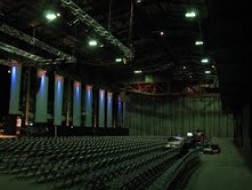
To Mic, or Not to Mic
Jeffrey Zeigler
I must admit that I myself am relatively new to the use of sound design. Previous to joining Kronos I had only dabbled here and there, and even then only in small amounts. Like so many cellists that graduate from conservatory, it really wasn’t something that I encountered very much except in specific 20th century works that required its use. In fact, I would say that, like so many, I viewed the use of amplification as a form of cheating.

To some degree, I do not completely disagree with this notion. Like all tools, it isn’t the tool itself that is the problem, but what one chooses to use it for. If one uses amplification simply in order to play louder, then you are in fact cheating. However, like any other tool, there are a myriad of options at one’s disposal if you choose to use sound design for artistic pursuits.
Sound Design
 Naturally, one probably should avoid using a flanger while playing a Bach Suite. However, there are an increasing number of pieces that are being written that do call for some form of sound design. This can be anything from distortion, delay, octave dividers, looping and a multiple number of reverbs just to name a few. There could also exist a backing track that may include pre-recorded tracks with or without electronic manipulations or found sounds recordings. All of these possibilities are not merely effects meant to mask some technical flaw in one’s playing. They are compositional tools intended to heighten dramatic effect or to help create the sound world that a particular piece exists within. By not opening oneself up to the use of sound design, you are actually closing yourself off from a wealth of really great music that is available to you.
Naturally, one probably should avoid using a flanger while playing a Bach Suite. However, there are an increasing number of pieces that are being written that do call for some form of sound design. This can be anything from distortion, delay, octave dividers, looping and a multiple number of reverbs just to name a few. There could also exist a backing track that may include pre-recorded tracks with or without electronic manipulations or found sounds recordings. All of these possibilities are not merely effects meant to mask some technical flaw in one’s playing. They are compositional tools intended to heighten dramatic effect or to help create the sound world that a particular piece exists within. By not opening oneself up to the use of sound design, you are actually closing yourself off from a wealth of really great music that is available to you.
Collaborations
 Through the use of amplification, one has the ability to play together with instruments that otherwise would be impossible. I’ll give an example: a few years ago my quartet made a recording with the Afghani rubab virtuoso, Homayun Sakhi. This guy plays like Heifitz. But without amplification you would never know because it would be impossible to hear him as the rubab is acoustically much quieter than a violin, let alone a string quartet. But through the use of technology we can actually create a balance that brings forward all of the parts. Without sound design, this collaboration would have been impossible, which would have been a tremendous shame. Without a doubt, this is one of the most inspiring collaborations that I have ever been a part of.
Through the use of amplification, one has the ability to play together with instruments that otherwise would be impossible. I’ll give an example: a few years ago my quartet made a recording with the Afghani rubab virtuoso, Homayun Sakhi. This guy plays like Heifitz. But without amplification you would never know because it would be impossible to hear him as the rubab is acoustically much quieter than a violin, let alone a string quartet. But through the use of technology we can actually create a balance that brings forward all of the parts. Without sound design, this collaboration would have been impossible, which would have been a tremendous shame. Without a doubt, this is one of the most inspiring collaborations that I have ever been a part of.
The Hall
 Kronos plays a lot of concerts in many different types of halls. Some are truly sublime and others are, well, not. Some are very large and some very intimate. As we all know as performers, one needs to make certain adjustments with regard to tempo and technique in order to project in the varying sizes and acoustics of concert halls. However, the reality is, in a large hall a small group will sound small and far away. With the use of sound design, one is able to create the kind of presence that the ensemble wishes to convey. And, in so doing, one is able to work with a wider color and dynamic range enjoyed only in the most ideal acoustics. I suppose one could be tempted to call this cheating. However, I would actually prefer to call it quality control.
Kronos plays a lot of concerts in many different types of halls. Some are truly sublime and others are, well, not. Some are very large and some very intimate. As we all know as performers, one needs to make certain adjustments with regard to tempo and technique in order to project in the varying sizes and acoustics of concert halls. However, the reality is, in a large hall a small group will sound small and far away. With the use of sound design, one is able to create the kind of presence that the ensemble wishes to convey. And, in so doing, one is able to work with a wider color and dynamic range enjoyed only in the most ideal acoustics. I suppose one could be tempted to call this cheating. However, I would actually prefer to call it quality control.
There is really so much to discuss when addressing the issue of sound design. In later posts, I am going to bring forward ideas behind the use of specific equipment and the issues surrounding the work of a sound designer.
Subjects: Technology

